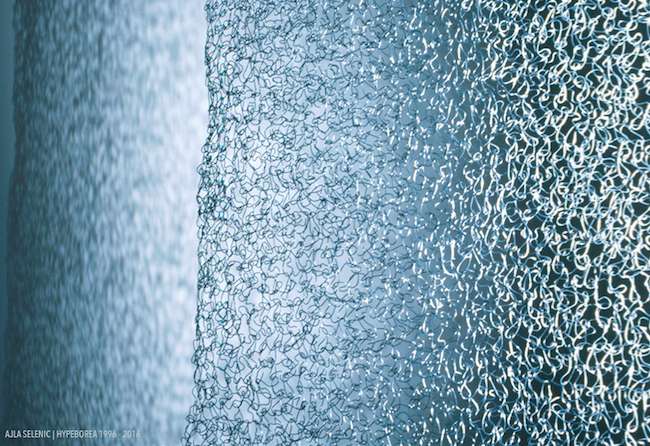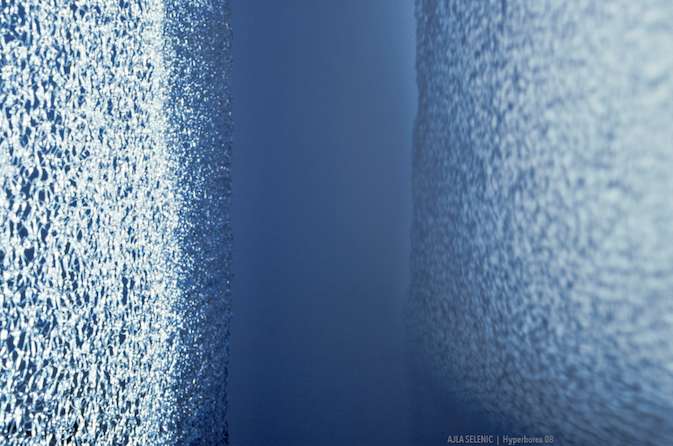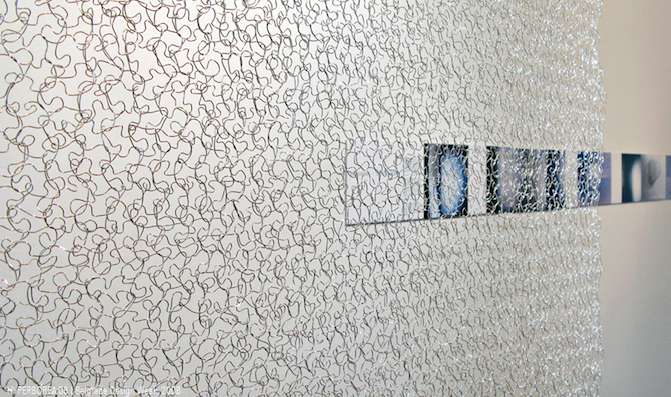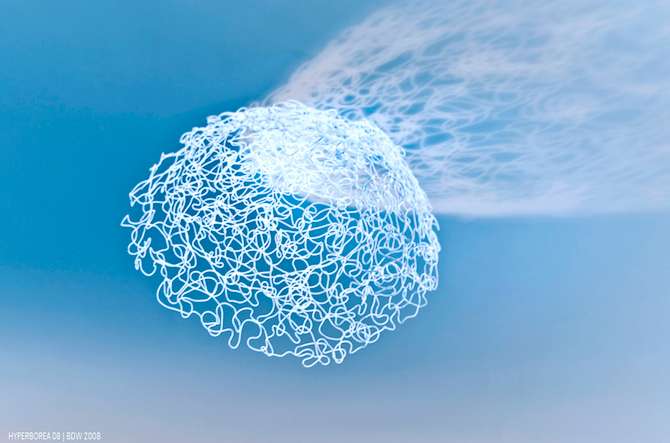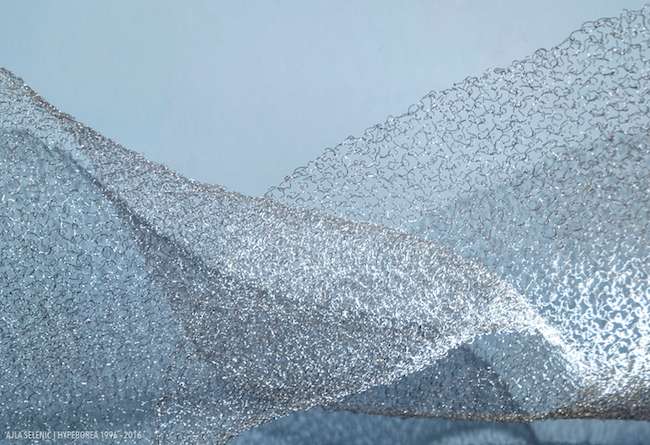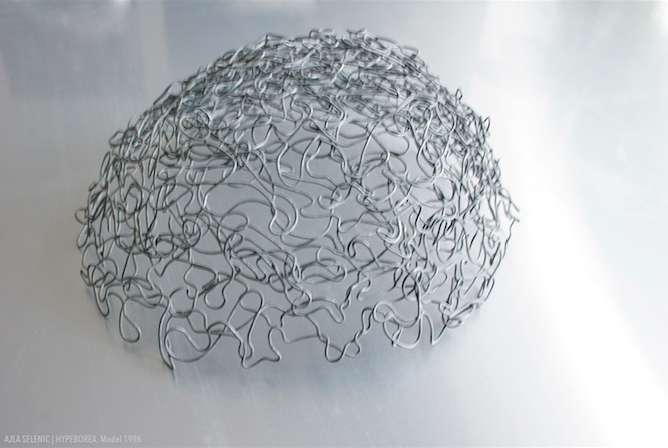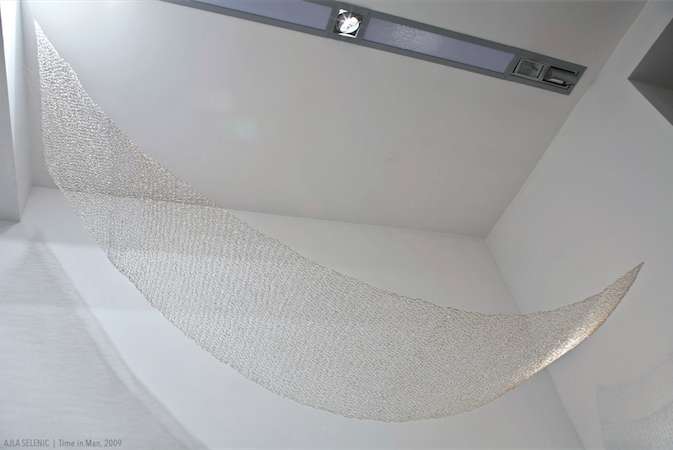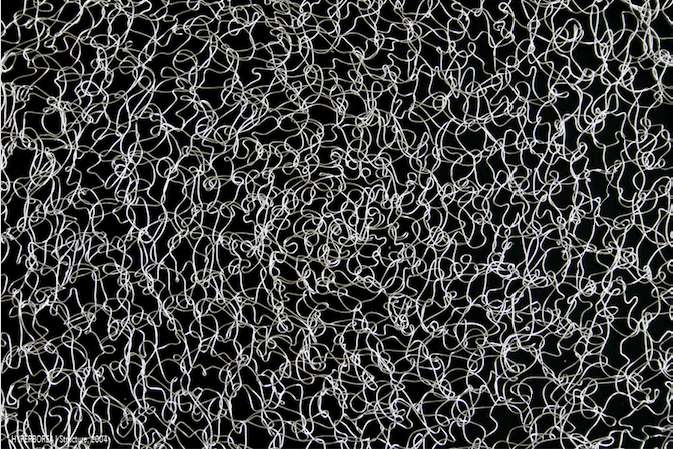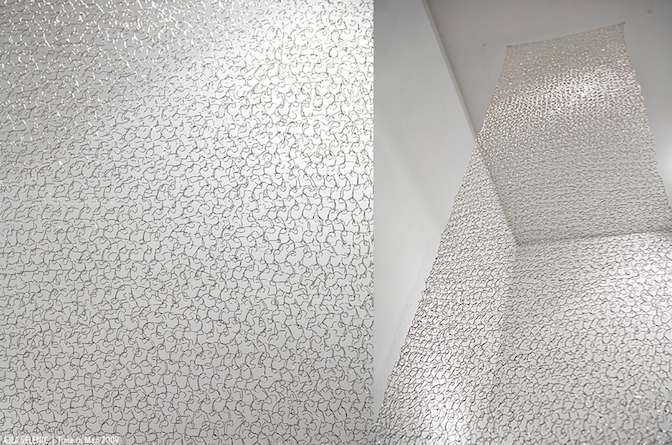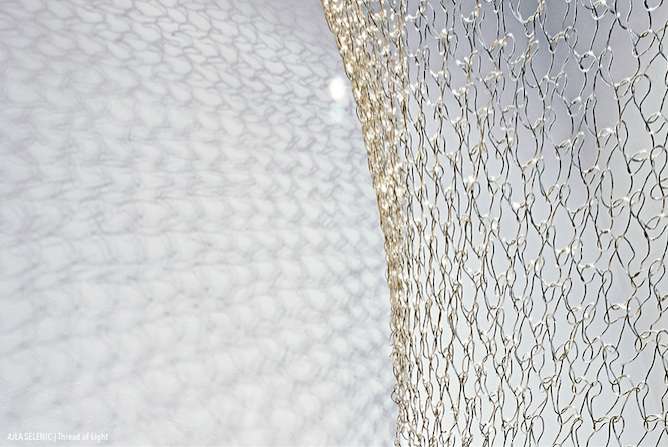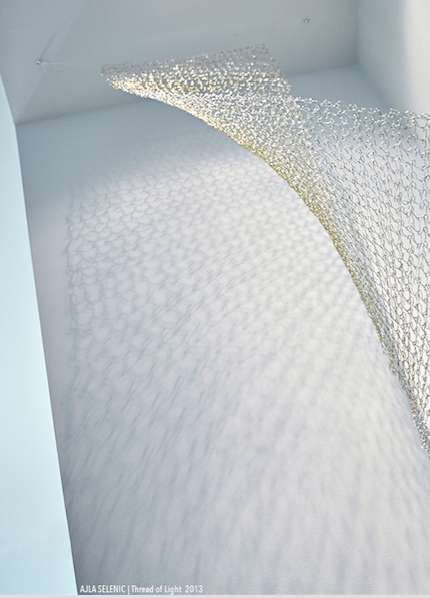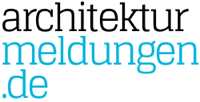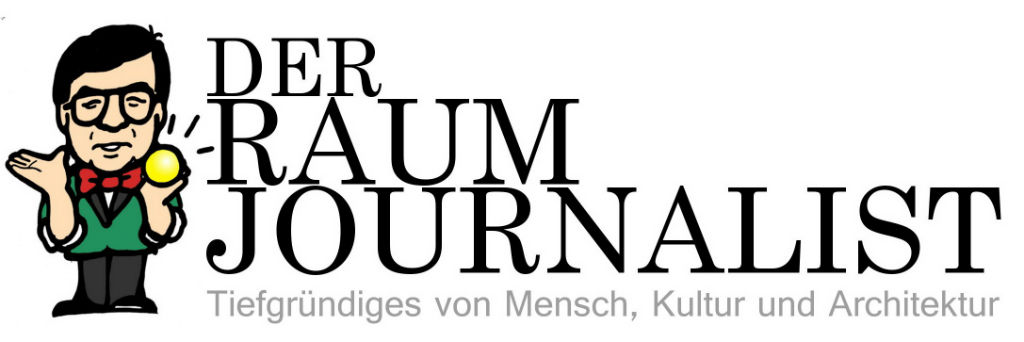“… transforming invisible threads of the notional world of ideas and the emotional content into the space of the visible world.“ INTERVIEW with Ajla Selenic
Delicate net-like structures intertwined to metallic tissues, delicate and translucent, they extend into the space they are located in, transforming and changing the feel, the sense of space: Hyperborea, Serbian architect and artist Ajla Selenic, based in Finland, calls her works, a series of continuous art and research projects.
“Hyperborea“ was an imaginary realm of eternal spring in Greek mythology, located “beyond the North wind”, however without certainty that it ever existed. For Selenic, it is a reference to the world of immaterial space, the world of ideas and of the transcendental. Over the years, she developed an intuitive method, a particular manual technique of bending metal wires in endless repetition, thus trying to explore “the poetics of space”. The simple linear thread is transformed into surface, the surface is transformed into three-dimensional spatial installations – raising questions of the ontological qualities of space and form, questions of the meaning of creative work.
In this deconarch.com interview Ajla Splenic reveals her intuitive working process and gives us insight into her thoughts’ cosmos.
all illus. (c) Ajla Selenic
www.hyperborea.portfoliobox.me
INTERVIEW
You were educated as an architect. How and when did you start to work as an artist, too?
All creative work begins within the inner space of our being, as a subconscious response of our inner philosophy, I believe. Besides being an architect for many years, I have always been profoundly focused on philosophy and literature, on reflections of the most essential questions of human life and its meaning. In the first period of my early architectural works in the 1980s, philosophy was an invisible path of my search towards the essential beliefs.
In my second phase, in the early 1990s, working on architectural projects and developing further my creative language, I took up a new path of following my intuition as a method, and consequently the area of my creative search expanded into design and art. My continuous inner metaphysical contemplation became inseparable from my creative search in architecture and particularly in art, exploring the poetics of space and the invisible bonds between the inner space of the soul and the abstract language of space and light in creative work.
How do the different disciplines, art and architecture, influence each other in your work – or do they differ?
Instead of differentiating, I was rather focused on what essentially interconnects the different areas. The most enthralling and meaningful strain for me was to reveal the invisible connections, in time, in space, in different scales of perception. All various disciplines and phenomena are, however, ultimately related to human life. The ultimate value or meaning of any achievement can only be measured by its impact on the human soul. In fact, the material achievements are often useless or can be detrimental if we lack a more profound awareness of the immaterial values and their meaning. That is the most important bond between any disciplines, something I am focused on. Thinking of architecture, science, design, all creative disciplines and art, perhaps art, philosophy and poetry have the most profound importance and impact as an awareness of the immensity, of the connection between the human soul and the unconceivable. And returning to architecture – on its highest level as a form of art, architecture should reflect the entirety of that span as well.
For years, you have been working on your project Hyperborea. What is it?
Hyperborea is a series of continuous art and research projects, implying an invention of creating large transparent spatial installations growing from a single linear element. It came into being as my own artistic and experimental study of space, following the intuitive, inner need to research the essential themes within architecture and art, in relation to philosophy, ontology and poetry of space. It reflected my questioning of the core meaning of creative work and our existence, the relationship between creativity and freedom, between space and time, the meaning of time and dedication inherent to our work. It also meant conveying the essence of ineffable energy into a visible form, transforming invisible threads of the notional world of ideas and the emotional, spiritual content into the space of the visible world.
What does Hyperborea mean?
“Hyperborea“ was an imaginary realm of eternal spring in Greek mythology, located “beyond the North wind”, however without certainty that it ever existed. Relating to my work, it alludes to the world of immaterial space, the world of ideas and the realm of the spiritual, the space of the transcendental. Within a span of many years, my abstract work – of researching form and space generated by simple linear elements of a metal thread and of instinctively created structures in which the linear element is transformed into the surface, and further, surface is transformed into the three-dimensional space installations – lay the questions of the ontological qualities of space and form, questions of the meaning of creative work, the border of real and unreal, of visible and invisible in our grasping of the most essential in life.
The constructive core of Hyperborea is the repetitive forming and shaping of a linear thread – a technique very reminiscent of parametric architectural design, yet you were and are working manually only.
The principal constructive theme of this work is the aspect of structure, growth and initial creating of space, by inventing my own technique of bending a simple linear element of straight uninterrupted metal thread which created the surface, and further transformed into the space, three-dimensional forms. Therefore – “From linear to surface, from surface to space”.
I started this project in 1996, at the time of my withdrawal into the solitude of spiritual contemplation and creative search. Few decades later, it seems as if it had indicated an entire new chapter in architecture – nowadays there have been many projects all over the world designed as parametric architecture, using similar structural systems formed by linear elements as a free form transparent membrane. At the time of my invention, however, I was not able to realize any architectural projects of that kind, except few art exhibitions in Helsinki and Austria. Neither was I ever willing to use that idea in producing any design items in mass production. I deliberately avoided any pragmatic use of this invention, rather focused exclusively on a pure abstract concept, realm of conceptual project of creating an ontological space.
The fact that these installations have been made by hand, expressed my necessity to communicate the ideas of a single human being in the most genuine way, avoiding the use of technology in reaction against all technocratic impositions of the contemporary world. Above all I wished to emphasize the conceptual, contemplative, emotional and ontological content as the most profound meaning of any creative work, the world of ideas versus the material world. Therefore – “From material towards the Immaterial”.
How did you discover this one constructive principle? What were the thoughts leading to it?
I am continuously designing something in my mind, many times subconsciuosly, and most ideas derive from the entire inner space of thoughts, emotions and spiritual impulses. One day I incidentally found a piece of metal wire in my studio and spontaneously tried to make something constructive with it. It was a moment of freedom to take a new path, into an unknown area. That was a mystical moment of inspiration, rejoice of searching and spontaneously allowing the intuition to lead my work. As soon as I have made the first transparent surface and a self supportive three-dimensional model with a beautiful irregular pattern, that could take any possible form, I immediately imagined huge transparent spaces made in the same way. Perhaps that was an echo of Bachelard’s texts I had been reading as a student of architecture, which were so touchingly similar to my sensibility and remained in my soul for years.
However, at that time, in 1996, I was deeply nostalgic for my home country, and continuously reading one of my beloved writer and poet, Milos Crnjanski, who over many years, or perhaps even after the first time I read his verses, became a soul friend of mine in my involuntary exile. Project Hyperborea is also related to the poetical space of his writing.
Are there other works, series, related to Hyperborea?
There are several other series continuing the same conceptual project, Time in Man, exhibited in the Gallery Zvono, Belgrade, in 2009, and Thread of Light, the most recent works.
Time in Man emphasizes the meaning of our awareness of time, our individual perception of how we relate to the notion of time. In other words, the exploration of our own ability to become aware of the transcendental dimension of time, of time in its entirety, a time beyond time – not limited only to what we see in present times, but a much more complex and profound awareness.
The special technique of bending the metal wire which I invented to create these works, demands great consistency, sacrifice and patience bordering almost on senselessness, especially nowadays when we live under such an unavoidable pressure and demand for the speed and ceaseless productivity. However, I have never submitted to the euphoria of contemporary impositions, believing in the integrity of individual, spiritual and transcendental values.
Another important meaning of that exhibition was a reversal to the usual attitude of accepting the dependence of living in a certain time of the world’s actual history, limiting us to certain boundaries. Instead, as much as man lives in a certain period of time, the time in its entirety lives in everyone of us. That revelation can bring us much more profound meaning to all what we create and live for.Â
Where do you find your topics?
In my inner life, in my dreams, in my solitude, in my love and faith, in my care and concern for humankind, in my endless search for the essential, in the limitless contemplative world of metaphysical space, shared with many other souls, shared with eternity.
I am never searching for topics, I live imbued into the constant reflections on the most essential and unfathomable themes of human existence, open and sincerely emotionally involved in life, and as a consequence some meaningful questions and insights rise in their own time. I am just trying to be aware of the most essential and truthful in life.
How is your working process?
My working process is extremely introvert and silent. I have a constant flow of inspiration, and am continuously developing several different ideas in my thoughts. Most of the ideas come in a flash, in an instant, and many of them I never even have a possibility to bring to real life.
A very important part is grasping the ideas and thoughts by sketches and writings, which has grown into a form of diary of insights. Often, in my dreams, I see architecture, spaces, entire cities, ideas of my next projects – most valuable insights for my work. Some other, mostly artworks have an extremely slow process of obtaining a final form. However slow and sometimes painful the process is, I always follow my inner voice and creative stream that brings me yet to another area. My working method is a freedom to listen to the inner self and to follow a theme that becomes a genuine, important spiritual insight. After many years of very different projects and works, I am trying to make a synthesis of what was most essential, valuable and true.
Which materials do you work with, why?
Materials are not the main focus of my attention, my focus either in work or in life, is always on the immaterial. I could say that “materials I work with” even in architecture, are primarily emotions, thoughts, ideas, memories, spiritual energy, awareness, time, a realm of the transcendental. The material used in my artwork is usually chosen by intuition, and during the work itself I often discover retrospectively what was the unconscious reason of my choice. In the Hyperborea works, structures made of metal which is a hard, solid material became transformed into soft, airy and weightless installations. Even in architecture, the most important traits of space, for me, are qualities of immaterial essence.
Are there role models, influences which inspire your work?
Certainly the first influential and inspiring people for me were my parents, both of them artists, designers. I have grown up in an atmosphere of inexhaustible creativity and great appreciation of art. My father, Slobodan Selenic, one of the first Serbian designers, was a person with unforgettable charisma, talent and integrity.
In my formative years, the strongest influence came from the literature. I became a passionate reader at a very young age, inseparable from books and the thoughtful, emotional and contemplative world of literature, poetry and philosophy. My passion was to understand the human soul, the emotions and their transformative enegry, to find a philosophical and spiritual base from which to construct life. Among many beloved classical writers, certainly one who influenced me most in my youth was Fyodor Dostoyevski. Also, very close to my soul were, among many outstanding Serbian writers and poets, Milos Crnjanski, Momcilo Nastasijevic, Branko Miljkovic …
My search through philosophy would be impossible to entirely retrace here, and it still continues …
In relation to architecture, to mention just two thinkers absolutely close to my perception of space: Gaston Bachelard and, recently discovered, Anne Tyng. Among many great artists, Christian Boltanski, Ljubica Maric, Doug Wheeler, Agnes Martin, Robert Lax…
The most profound influence, the utmost respect and a unique place in my soul has one of the greatest artist of the twentieth century, Andrei Tarkovsky. His trancendental presence and prophetical insight into existential depths of mankind, has permanently illuminated my own inner path.
However I feel that I was not directly influenced, rather I was searching the voice that resonated with what was already profoundly existent in my soul. The most important moments through the endlessness of human thoughts and a myriad of artists and creative personalities is the memorable feeling of revelation, when in someone’s work I can recognize a part of my own soul, or feel meeting my soul friend. That kind of soul connections beyond time and space is something that makes me feel touching the core of existence.
Ajla, thank you so much for sharing your thoughts with us!

